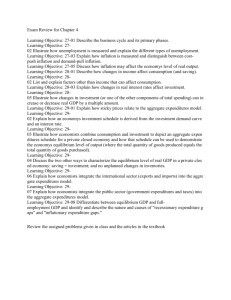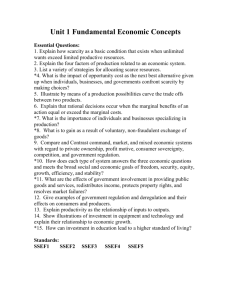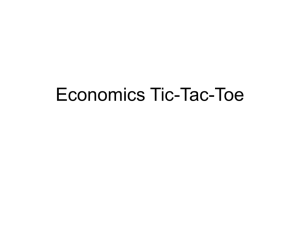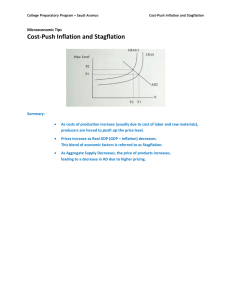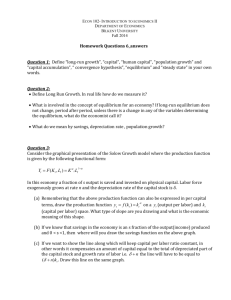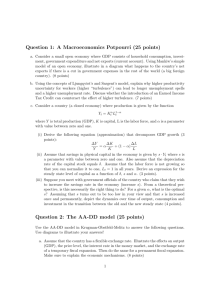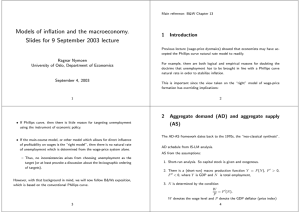Intermediate Macro
advertisement
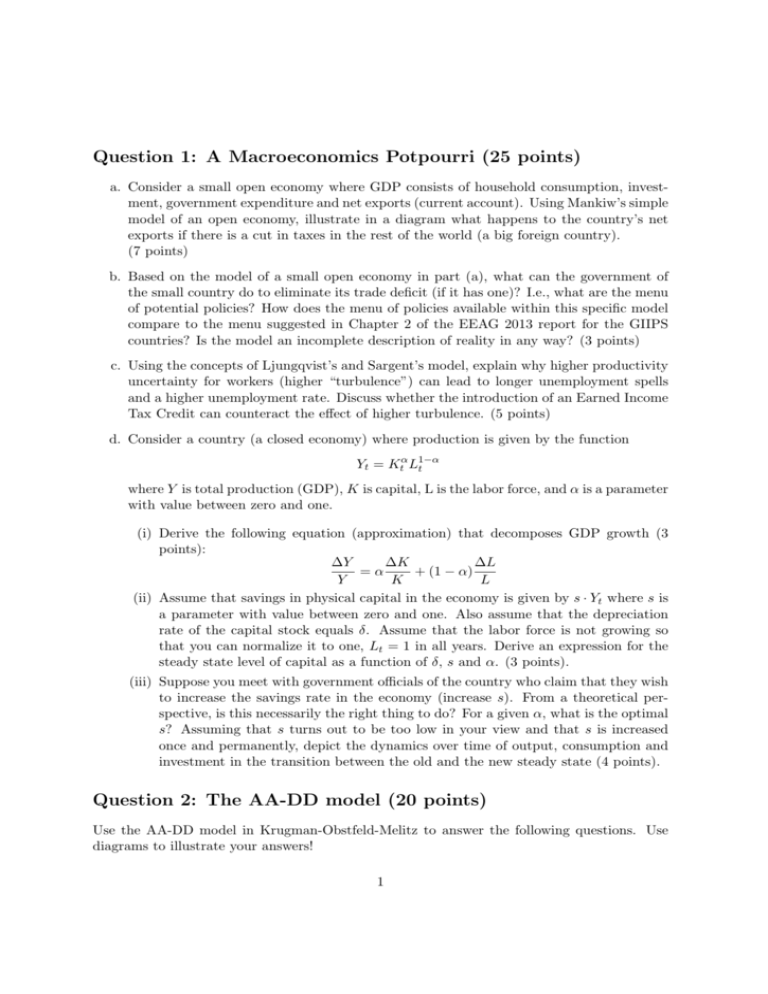
Question 1: A Macroeconomics Potpourri (25 points) a. Consider a small open economy where GDP consists of household consumption, investment, government expenditure and net exports (current account). Using Mankiw’s simple model of an open economy, illustrate in a diagram what happens to the country’s net exports if there is a cut in taxes in the rest of the world (a big foreign country). (7 points) b. Based on the model of a small open economy in part (a), what can the government of the small country do to eliminate its trade deficit (if it has one)? I.e., what are the menu of potential policies? How does the menu of policies available within this specific model compare to the menu suggested in Chapter 2 of the EEAG 2013 report for the GIIPS countries? Is the model an incomplete description of reality in any way? (3 points) c. Using the concepts of Ljungqvist’s and Sargent’s model, explain why higher productivity uncertainty for workers (higher “turbulence”) can lead to longer unemployment spells and a higher unemployment rate. Discuss whether the introduction of an Earned Income Tax Credit can counteract the effect of higher turbulence. (5 points) d. Consider a country (a closed economy) where production is given by the function Yt = Ktα Lt1−α where Y is total production (GDP), K is capital, L is the labor force, and α is a parameter with value between zero and one. (i) Derive the following equation (approximation) that decomposes GDP growth (3 points): ∆Y ∆K ∆L =α + (1 − α) Y K L (ii) Assume that savings in physical capital in the economy is given by s · Yt where s is a parameter with value between zero and one. Also assume that the depreciation rate of the capital stock equals δ. Assume that the labor force is not growing so that you can normalize it to one, Lt = 1 in all years. Derive an expression for the steady state level of capital as a function of δ, s and α. (3 points). (iii) Suppose you meet with government officials of the country who claim that they wish to increase the savings rate in the economy (increase s). From a theoretical perspective, is this necessarily the right thing to do? For a given α, what is the optimal s? Assuming that s turns out to be too low in your view and that s is increased once and permanently, depict the dynamics over time of output, consumption and investment in the transition between the old and the new steady state (4 points). Question 2: The AA-DD model (20 points) Use the AA-DD model in Krugman-Obstfeld-Melitz to answer the following questions. Use diagrams to illustrate your answers! 1 a. Assume that the country has a flexible exchange rate. Illustrate the effects on output (GDP), the price level, the interest rate in the money market, and the exchange rate of a temporary fiscal expansion. Then do the same for a permanent fiscal expansion. Make sure to explain the economic mechanisms. (10 points) b. As in part (a), assume that the country has a flexible exchange rate. Illustrate the effects on output (GDP), the price level, the interest rate in the money market, and the exchange rate of a temporary monetary expansion. Then do the same for a permanent monetary expansion. Make sure to explain the economic mechanisms. (10 points) Question 3: The AA-DD and the DAD-DAS model (25 points) Please note that part (a) and part (b) of this question can be answered independently. a. In the lectures we have covered the AA-DD model of Krugman et al.’s text book as well as the DAD-DAS model of Mankiw’s text book. (I) Describe the main economic actors and markets in each model. (4 points) (II) Are there differences in the characterization of the short-term equilibrium? Are there differences in the (microeconomic) assumptions? Which ones? (3 points) (III) For the following three policy settings which model would you prefer to use? Briefly motivate your choice (3 points). (i) The analysis of a one-time temporary increase in government spending (fiscal expansion) in a small open economy (ii) The analysis of the consequences of a too ”hawkish” central bank (a central bank that for some time penalizes inflation too much) (iii) The analysis of a permanent legal ban on firms’ ability to adjust prices frequently (say more than once every third year or so), combined with a permanent one-time increase of the money supply. b. Consider the following two equations that describe the DAD-DAS model: The DAS-curve: πt = Et−1 πt + φ Yt − Y + vt The DAD-curve: Yt = Y − αθπ 1 (πt − π ∗ ) + εt (1 + αθy ) (1 + αθy ) where πt denotes inflation at time t, Yt denotes output at t, Y denotes the natural level of output, and φ, α, θy are parameters with values strictly greater than zero. vt and εt are shocks to supply and demand, respectively. Finally, π ∗ denotes the central bank’s 2 inflation target and Et−1 πt denotes the expectation of inflation at time t based on information available at time t − 1. In the following, suppose that the economy initially at time t−1 (and in all previous time periods) was in a long-run equilibrium denoted by A. Up until that point, the central bank had an inflation target π ∗ = π A . Then, in the beginning of time t, the central bank announces a new inflation target π ∗ = π B where π B > π A . Assume that the supply and demand shocks vt and εt are equal to zero in all time period. (i) Assume that all agents form inflation expectations adaptively, i.e. that Et−1 πt = πt−1 . Illustrate by means of a diagram how the economy makes the transition from the initial long-run equilibrium (the one prevailing up until time t − 1, denoted by A) to the new long-run equilibrium (the one denoted by B). Be particularly careful to describe the economy’s output and inflation at time t and to contrast it to the old equilibrium (A) and to the new long-run equilibrium (B). Is it necessarily the case that πt+1 = π B ? (8 points) (ii) Now instead suppose that we want to implement rational expectations in the model. This means that Ej−1 πj = π A for j ≤ t and Ej−1 πj = π B for j > t (the economic agents are taken by surprise at t). As in part (i), illustrate how the economy makes the transition from the initial long-run equilibrium (A) to the new long-run equilibrium (B). Be particularly careful to report inflation and output in period t and t + 1. Is πt+1 = π B ? (7 points) Question 4: Financial Crises (20 points) This is an essay question. While you are only expected to verbally answer the questions below, still try to use sound economic reasoning and concepts for economic policy making discussed in lectures and seminars. Your total answer should not exceed 3 pages. a. Please write no more than 2 pages. Try to be brief and to the point. In chapter 20 of Mankiw’s text book, six common features of a financial crisis are listed. Describe these features. For the first five features, substantiate the description by adding examples of particular phenomena or events from the U.S. experience between the mid 2000s to 2009. (14 points) b. Please write no more than half a page. Based on what you learnt in Lecture 9, please describe the Fed’s policy stance in the beginning of the Great Depression, both in terms of monetary policy and in terms of lender of last resort activities. Was its stance helpful for reviving the economy? Among all U.S. policy initiatives, which are believed to have helped? (3 points) c. Please write no more than half a page. As a response to the financial crisis in 20082009 the Riksbank (Sweden’s central bank) undertook several unconventional financial stability policy measures. Describe those. Please be precise. (3 points) 3 Question 5: Intertemporal Consumption Choice (10 points) Credit question. This question should only be answered by students who have not obtained credit from the seminar series. Consider a two-period model where consumption in period 1 is given by: C1 = Y1 − S1 and consumption in period 2 is given by: C2 = (1 + r)S1 + Y2 where C1 , Y1 and S1 are consumption, income and saving in the current period and C2 and Y2 are consumption and income in the next period and r is the real interest rate. a. Derive the household’s intertemporal budget constraint. (2 points) b. Suppose that the household is saving initially and that it has continuous, convex indifference curves. Illustrate the household’s optimal choice in a diagram (4 points) c. Analyze the impact of an interest rate decrease. Use a diagram to support your verbal arguments. Feel free to assume that the household continues to save after the decrease. (4 points) 4
